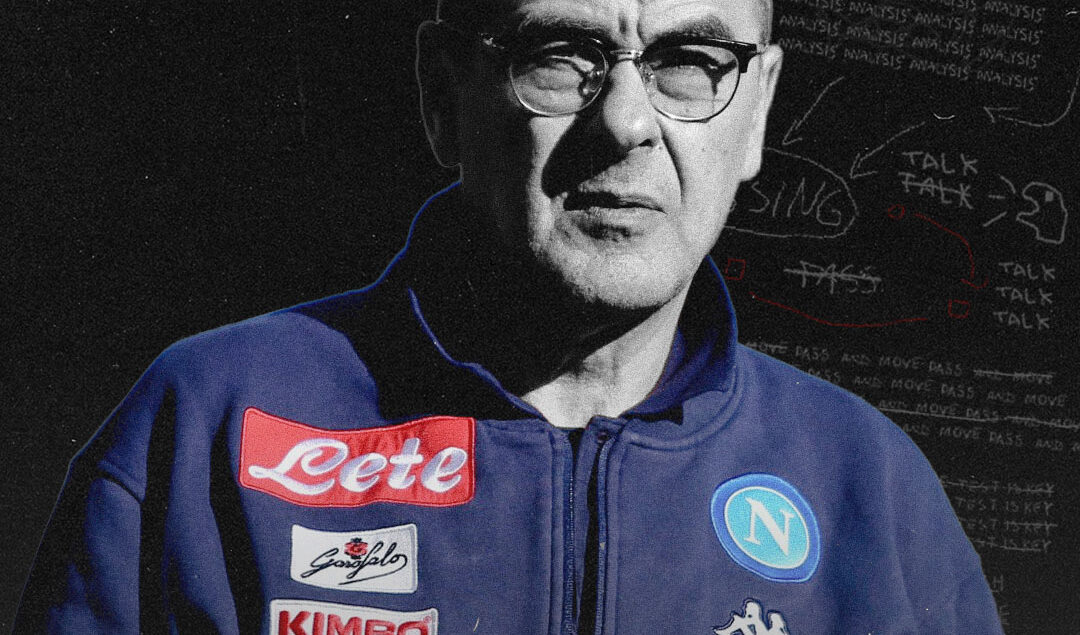Through the Looking Glass of Big Data: SSC Napoli 2015/16 and the Vindication of Maurizio Sarri: Part One
Before Luciano Spalletti’s new-look Napoli led by Kvicha “Kvaradona” Kvaratskhelia and Victor Osimhen conquered the Serie A in 2022/23 for the first time since a certain Argentinian had led them to the Scudetto over 30 years prior, it was the unassuming rise of Maurizio Sarri seven years prior that had seemingly marked the start of a new era in the history of the club.
Sarri’s appointment to the top job in July 2015 at Napoli had come as a surprise to many in the Neapolitan media as he beat out the more-vaunted likes of Cesare Prandelli and Luciano Spalletti himself to replace Rafa Benitez, freshly departed for Real Madrid. “We won’t have a winning Napoli with him,” the typically outspoken Diego Armando Maradona told the press at the start of the season. “I’d have kept Benitez. Sarri is a good person, but he is not worthy of Napoli.”
Not quite a ringing endorsement from the club’s greatest legend. Sarri, however, was not unused to unheralded beginnings and responded simply to Maradona’s critical comments by describing it as “an honor” that the great Argentinian had even heard of him in the first place. This three-part series will examine Sarri’s unlikely rise to the elite of Italian calcio and chronicle the story of his first year at Napoli in the 2015/16 season through the lens of big data and tactical analysis, courtesy of the free data available online from Statsbomb. We hope you enjoy reading as much as we enjoyed watching the rise of “Sarri-ball”, all those years ago.
Part I: The Curious Case of Maurizio Sarri
Born in Naples in 1959, Sarri had studied Economics, Commerce and Statistics at university and originally began his professional career as a banking consultant in Florence, working in the mornings and playing for amateur sides in Italy in the afternoons before switching from playing to coaching in 1990 at semi-professional club U.D. Stia 1925.
Though he continued to balance his banking work with coaching while hopping between lower-league clubs for the next decade, in 2002 Sarri left behind the corporate lifestyle to focus on football full-time after reaching Serie C2 with Sansovino. Stories of his meticulousness and attention to detail on the training pitch quickly began to gain notoriety, alongside his penchant for indulging in cigarettes and coffee during training. He earned the nickname “Mister 33” from his players after supposedly preparing 33 attacking set-piece routines, though he later admitted, “We only used four or five of them in the end.”
In 2006, following stints at Sangiovese and Pescara, Sarri replaced Antonio Conte to take charge of struggling Serie B side Arezzo, 12 years before replacing Conte again as manager of Chelsea. Though the side was still relegated, Sarri showed glimpses of his managerial prowess in Serie C the following season as Arezzo secured an astonishing 2-2 draw away to a then-second division Juventus side boasting the likes of Gianluigi Buffon and Alessandro Del Piero, and nearly knocked AC Milan out of the Coppa Italia quarterfinals with a 1-0 home win in the second leg, just unable to overcome the 2-0 first leg loss at the San Siro.
A Farewell to Luciano Spalletti, the Man Who Ended Napoli’s Scudetto Drought
Sarri continued working in short stints at various Serie C and B clubs, but it was only after his arrival at Empoli in 2012 that Sarri would begin to make his name on the world stage. At Empoli, Sarri implemented his trademark style of slick passing and aggressive, structured football, leading the club to fourth place and the Serie B playoff final in his first season where the club lost to Livorno. The following season he adopted the 4-3-1-2 formation and did one better, winning automatic promotion through a 2nd place finish to finally taste the glory of Serie A football, 24 years on from the start of his coaching career.
In 2014/15 Sarri led his unfavored side to a comfortable 15th place finish, avoiding relegation with ease and taking a few notable scalps along the way, including a 2-2 draw away to Napoli in December and a 4-2 demolition job in late April which grabbed the attention of Napoli’s vivacious film producer owner Aurelio De Laurentiis.

Sarri’s Favored Starting XI at Empoli (2014/15)
Sarri’s 4-3-1-2 tactic was centered around a midfield diamond with Mirko Valdifiori at the regista at the base of midfield, Daniele Croce and Matias Vecino as the carrileros shuttling up and down the pitch on either side, and the converted winger Riccardo Saponara operating as the trequartista in behind the strike duo of Massimo Maccarone and Manuel Pucciarelli.
A stringent central defensive partnership of teenage Juventus loanee Daniele Rugani and Lorenzo Tonelli, flanked on either side by Elseid Hysaj and Mario Rui and backed up by Napoli loanee Luigi Sepe between the sticks, conceded only 52 goals over the course of the season, 2 less than Napoli despite the 10 league places between them, and the fewest of the clubs in the bottom half bar only Chievo.
Other clubs quickly took notice of the young players on show, many of whom went on to earn moves to big clubs, including Validifiori, Vecino, Saponara, Hysaj, and Rui. Even the legendary ex-Milan manager Arrigo Sacchi was impressed, even if Maradona was still skeptical by the time of Sarri’s appointment. “When you see Sarri’s teams play, you know how they train,” he raved in an interview in 2015 before stating simply, “He is a genius.”
*****
Back in Naples, Benitez had enjoyed a reasonably successful two-year stint before his departure to Madrid, winning the Coppa Italia final 3-1 over Fiorentina in his first season and the Supercoppa Italiana at the start of his second, but the fans’ perception of him had soured quickly following a shock 2-1 loss on aggregate to Dnipro Dnipropetrovsk in the Europa League semifinal and lost 4-2 in dramatic fashion to Lazio on the final day of the 2014/15 season, effectively handing the Biancocelesti the third and final spot in next season’s UEFA Champions League at Napoli’s expense.
Napoli’s Scudetto Win and Victor Osimhen’s Capocannoniere-chasing Form
Though Sarri had certainly impressed the Napoli faithful in his two successful results with Empoli the previous campaign, he was still perceived as a risky appointment due to his lack of elite experience and was given just a yearlong contract by the club to turn things around. His work was certainly cut out.
Club legend Marek Hamsik, for example, was entering the prime of his career at age 27, but had often been left on the bench by Benitez for supposedly tactical reasons. 23-year-old center back Kalidou Koulibaly signed the previous season for €7M from Genk, had been criticized in his first season for his lack of mobility at the back alongside Raul Albiol as the side conceded 54 goals, the worst record of any team in the top 10 and the only club conceding 50 or more bar AC Milan, who finished catastrophically in 10th.
Perhaps the only bright spot was the attacking trident of Gonzalo Higuain, Jose Callejon, and Dries Mertens, who had combined for 35 Serie A goals between them in Benitez’s final season as the side hit 70 in the league, the 3rd highest behind only Juventus and Lazio.
But even this bright spot had its challenges, as Higuain and Callejon, both Benitez-era signings, were said to be considering their futures at the club. Crucially, Sarri was successful in convincing both of the ex-Real Madrid attackers of the merits of his sporting project; Higuain later commented that so impressive was his new manager’s presentation that it “took just a few minutes to convince [him] to remain at the club”.
In the mercato, Sarri brought in two of his ex-players from Empoli for a combined €10.5M in the forms of 21-year-old Albanian fullback Elseid Hysaj and the maestro Valdifiori, who was expected to replace to slot into his favored regista role at the base of midfield in place of a struggling Jorginho. 25-year-old defender Vlad Chiriches arrived from Tottenham to compete with Koulibaly, and ex-Liverpool goalkeeper Pepe Reina was signed permanently to provide experience in goal following a successful loan spell at Napoli two years prior.
The marquee signing, however, was the €12M acquisition of Udinese’s 25-year-old Brazilian midfielder Allan, a voracious duel-winner who had led Serie A by far for the most ball recoveries in 2014/15 and was expected to add some much-needed steel to the Neapolitan midfield.
*****
The first three fixtures of the season, with a match away to Sassuolo and home against Sampdoria before a much-vaunted return to Tuscany to take on his old side Empoli, felt like winnable affairs and a chance for Sarri to get off to a running start.

Napoli Starting XI vs. Sassuolo, Matchweek 1
Sarri deployed his charges in his favored 4-3-1-2 for the first match against Sassuolo. Chiriches made his debut alongside Raul Albiol in the center of defense, with veteran Christian Maggio on the right while the expected starting right back, the versatile Elseid Hysaj, started on the left due to injury due to Faouzi Ghoulam.
Valdifiori also made his debut in the heart of midfield, flanked on either side by David Lopez and Marek Hamsik, while the diminutive Lorenzo Insigne started as the trequartista behind the duo of Gonzalo Higuain and Dries Mertens, with the Belgian often dropping in alongside Insigne to create a 4-3-2-1 in attack.
Insigne had so far failed to deliver on his undoubted potential under Benitez and scored only twice in Serie A the previous season, but Sarri was convinced of the diminutive 23-year-old’s potential to be the key playmaker in attack. The dry-witted Italian aimed to convert his dynamic young winger into a central playmaker, much as he had done with Riccardo Saponara at Empoli to devastating effect, and affirmed to reporters in preseason, “According to Arrigo Sacchi, [Insigne] is the most talented Italian player right now.”
Sarri’s men got off to a dream start as Hamsik slotted home the rebound from Higuain’s shot in just the third minute to take the lead, but Napoli were twice caught out with balls in behind Christian Maggio as Antonio Floro Flores and Nicola Sansone led Sassuolo to a shock 2-1 victory.
Along with Maggio’s positional deficiencies, Valdifiori’s lack of mobility was highlighted as the first goal resulted from a massive space between the back line and midfield in transition, where young Domenico Berardi was able to freely recover a knock-down from a long ball with time and space to chip the ball over Maggio to the onrushing Antonio Floro Flores.
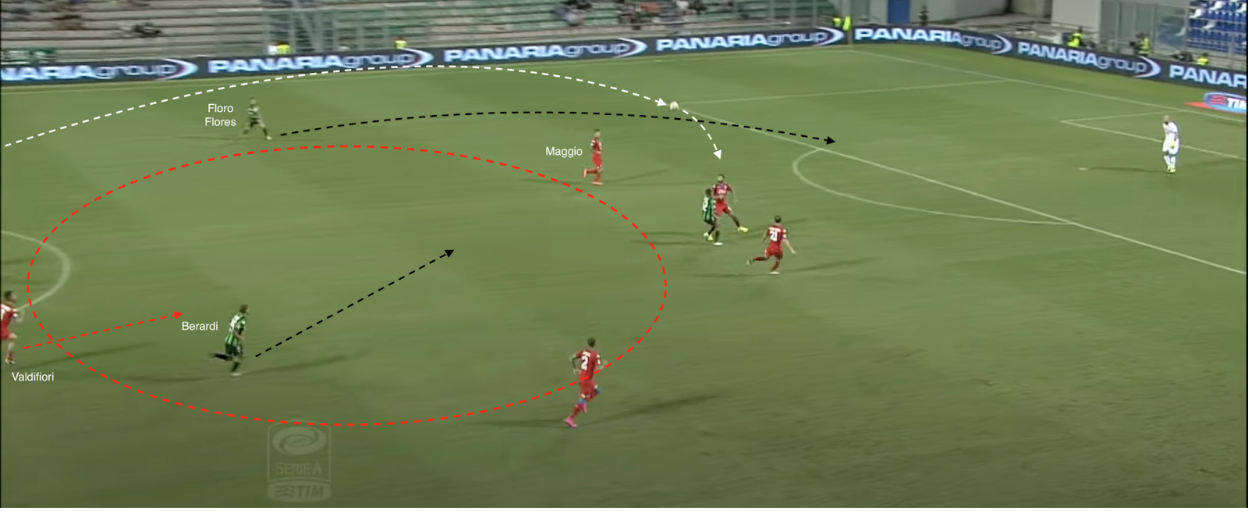
A long ball in transition is knocked down, which Berardi is able to pick up in acres of space between the midfield and the backline (shown in red) as Valdifiori (shown to the far left of the image) is caught out by the direct play. Berardi is then able to play in the run of Floro Flores (top of the picture) to score.
The next two matches resulted in disappointing 2-2 draws as Sarri persisted with the 4-3-1-2, first at home to Sampdoria as I Partenopei squandered a 2-0 halftime lead granted by a sumptuous braze from Gonzalo Higuain, then away to Sarri’s old employers as the Azzurri were forced to come from behind twice to earn a point on the road to Empoli. There were still positive takeaways for Sarri’s men, despite taking a paltry two points from nine.
Lorenzo Insigne was relishing his license to roam in the channels and drive at opposition defenses as the free playmaker, evidenced by a lovely assist for Higuain and a few brilliant attacking runs against Sampdoria, plus a wonder strike from outside the box against Empoli.
The team also looked competent in possession, averaging 60% possession in the first three matches and 527 completed passes per match, the most in the league and nearly 10% higher than the next closest team in Serie A. Highlighting Sarri’s commitment to a short-passing style, Napoli also had by far the lowest average pass length at 17.2 meters, with only Sarri’s old Empoli side coming close to the Partenopei’s record to date.
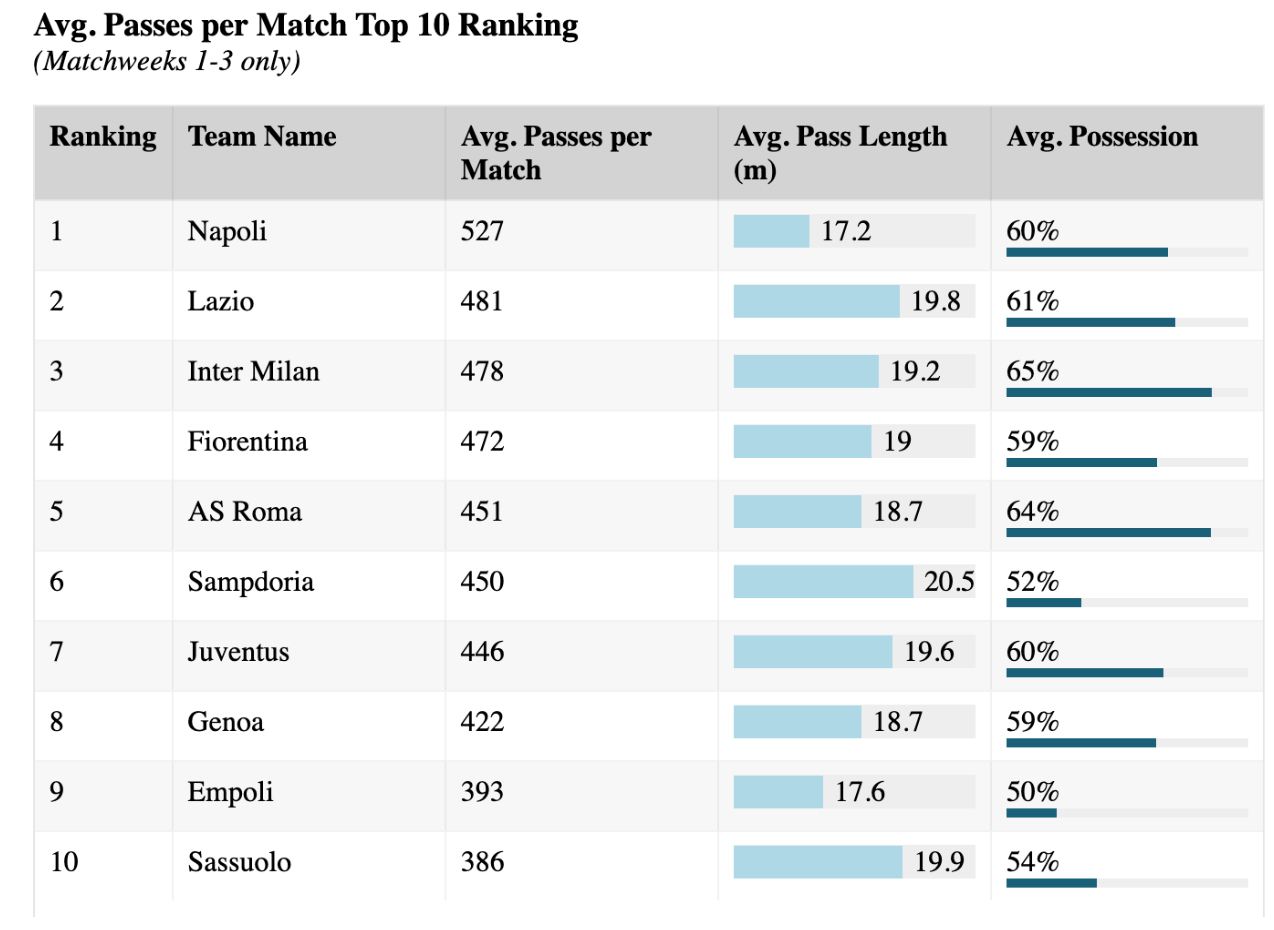
However, there were clear problems in the heart of midfield in defense. Though the 4-3-1-2 / 4-3-2-1 shape rang true in attack, Sarri intended his players to shift into a 4-4-2 in settled defense, with Insigne asked to drop back alongside Validifiori to protect the center of the pitch.
Given his free role as the main playmaker in attack, however, the young Italian live-wire was regularly caught up the pitch during defensive transitions, leaving the relatively slow Valdifiori exposed, as evidenced by the Floro Flores goal for Sassuolo in the season opener.
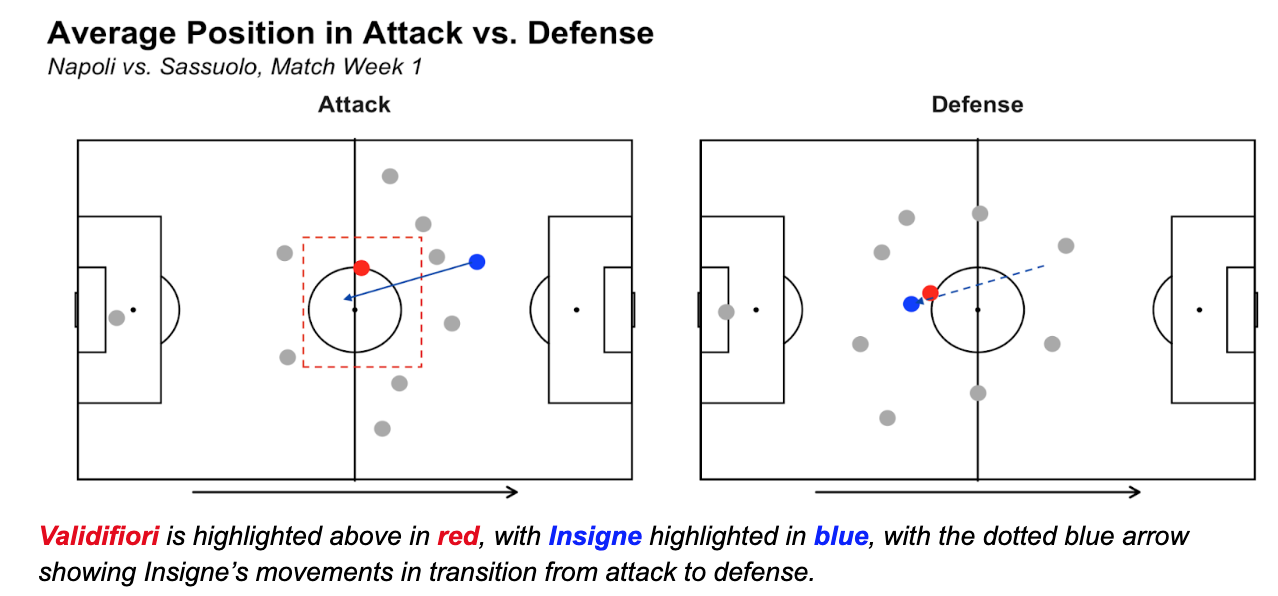
Sarri introduced Allan to the starting lineup for David Lopez after the first game to increase the combativeness in central areas, but his remit as the right-hand shuttler limited his contributions in the center and left Valdifiori still languishing in the middle.
As a result, although Napoli conceded a relatively stingy 43 shots in the opening three matches, the underlying data shows that the side was giving away a number of high-quality chances on the counterattack. Napoli’s 4.42 xG conceded sat nearer to newly-promoted sides Frosinone and Carpi than to the defensive elites of Juventus and Inter, and the side boasted the unwanted record of having the third-highest xG conceded per shot at over 0.1.
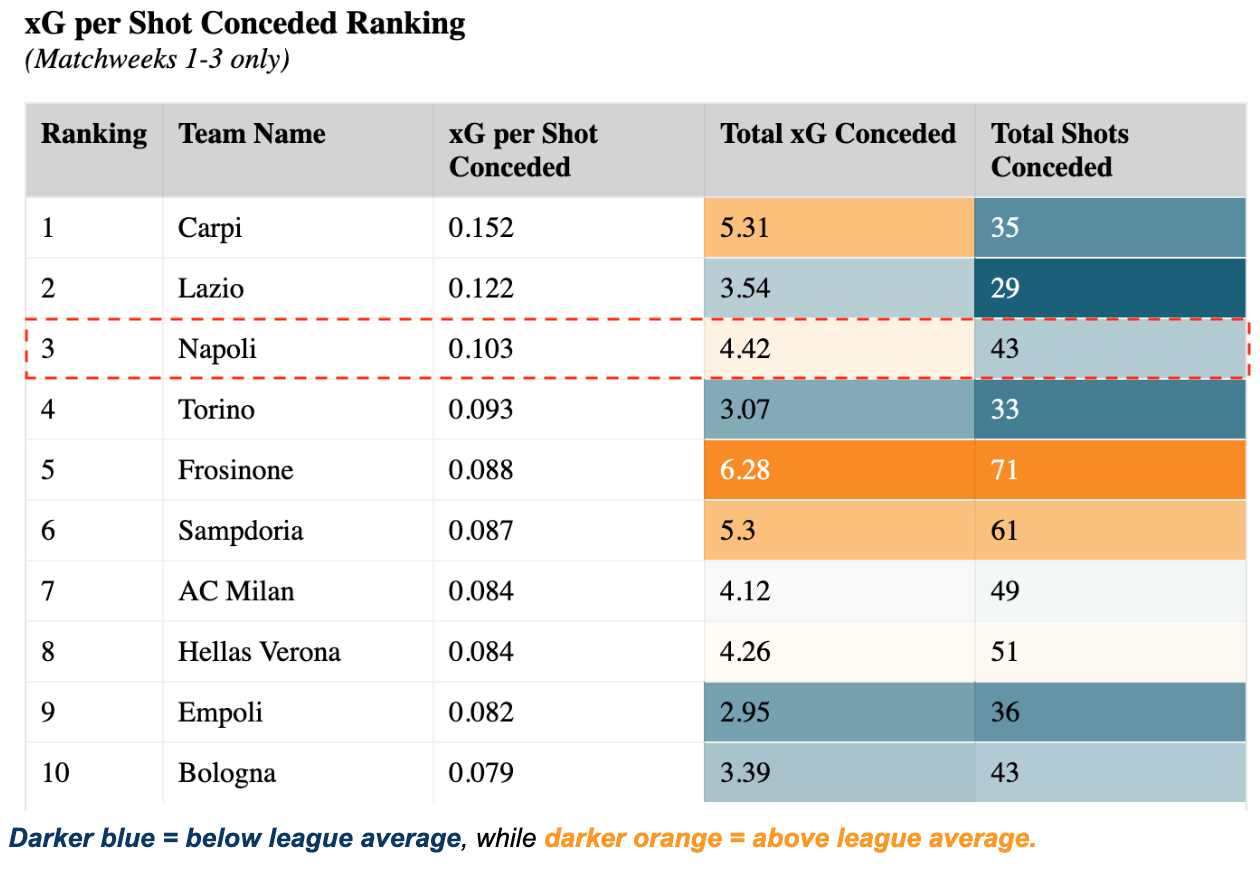
Changes were needed and swiftly; in midweek Napoli was set to host its Europa League opener against Club Brugge before welcoming Lazio to the Stadio San Paolo in a grudge match from last season’s final day heartbreak, followed by marquee matchups against Juventus and AC Milan in the following weeks which would were already being seen as season-defining matches for the struggling Partenopei.
By: Neal Hasan / @_____neal_____
Featured Image: @GabFoligno / Marco Canoniero / LightRocket
